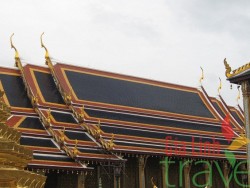Nong Nooch Garden
Thai Traditional Literature


Thailand

Waterfall
Thai Traditional Literature is essentially religious. Most of the literature in the old days consisted of works on Buddhism and Hinduism directly or indirectly. Whatever culture the Thai people brought with them from their homeland in Southern China where they had been in contact with Chinese culture for centuries was adapted to its later conception of Buddhism, their adopted religion. Traces of their original culture may be found here and there in a disguised and weak form embedded in their literature. Most of the works of emotive literature were written in veerse in various patterns. Five prominent examples of such works may be cited briefly.
1. The Romance of Khun Chang Khun Phaen, an indigenous story of love and pathos, at time humourous, of a triangular love plot of one heroine with two lovers. The story, apart from its beautiful expressions, contains a mine of infomation on old beliefs and social customs of the Thai before the impact of Western culture. The story as is known has been traslated into English and French.
2. Ramakian (or Ramakirti in transliteration) is the story based on the famous Indian epic, Ramayana. It is unique, containing many episodes and details which are not to be found in the original epic, but showing traces of contact with certain versions of the Ramayana in India, Malaysia, Java and Cambodia. There is an English translation.
3. The Romance of Inao. This is a translation from the well-known storty of adventures of the national Javanese hero prince. It is written in a refined and perfect style of the Thai Language and meant for dramatic performance.
4. Sam Kok. This is a translation from San Kuo Chi, a Chinese historical romance of the Three Kingdoms. Unlike the three preceeding ones, it is written in prose with perfect expressions of style of the language.
5. Phra Aphaimani: This is a romantic tale written in verse by one of the most famous and popular poets of Thailand. It is an imaginary tale of love, intrigue and adventure, and reflects some ideas of the people towards the Europeans of the last century. There is an English translation in concise form by one Prem Chaya.
The employment of prose in Thai emotive literature along the lines of the Western style is of recent date due obviously to the influence of Western literature.
The story
Phra Aphai Mani and his brother, Sisuwan were princes who were sent to study by their father as he hoped they could use the knowledge gained to rule the country, but Phra Aphai came back with the knowledge of playing the pipe and his brother at sword-fighting. Their father was angry and drove them away. But the pipe Aphai had learned was a magic one. Its sound could put people to sleep and take the soul out of the body causing death. One day while the others were lulled tosleep by the sound of the pipe, a giant came and took Aphai away to her cave where she transformed herself into a beautiful girl. He lived with her until she bore a son, Sinsamut. When Aphai found out that his wife was really the giant, Nang Phisua Samut, he fled with his son. He was assisted by a family of mermaids, father, mother and a daughter. The father and mother were caught and eaten by the giant. The daughter took Aphai and Sinsamut to Kokaew Phitsadan (Wonder Island) where a hermit saved them from the giant. The young mermaid later bore a son with Aphai, called Sutsakhon. One day a ship went by the island. In the ship were King Silarat of Phleuk with his daughter, Princess Suwannamali. She was engaged to marry Prince Usaren of Lanka. Aphai and Sinsamut asked to go with them on the ship, but on the way the giant attacked them and killed King Silarat. Aphai escaped to the shore and had to blow the pipe which killed the giant. Sinsamut swam with the princess to an island. They continued their journey and met Sisuwan and his daughter, Arun Rasami. They went on in search of Phra Aphai. Phra Aphai met Usaren who came out looking for his fiancee, Suwannamali. They went together until they met Sinsamut and Suwannamali. She refused to go to Usaren. There was a fight, Usaren fled back to Lanka. Phra Aphai came to Phleuk where the queen asked him to rule the country. Suwannamali was still angry at Phra Aphai for daring to give her up to Usaren, so she fled to become a nun. With the trick of a maid, Nang Wali, Suwannamali left the nunhood to marry Phra Aphai. She bore him twin daughters named Soisuwan and Chantasuda. Usaren and his father came back to attack Phleuk. The father was killed and Usaren died heart-broken. The throne of Lanka fell to his sister, nang Laweng. A very beautiful Laweng decided to take revenge and she declared to all the princes in countries around that whoever could kill King Aphai would have her and her Kingdom. Nine armies moved to surround Phleuk. Aphai followed Laweng and won her love but the war continued until a hermit came and helped to stop the war between them.
